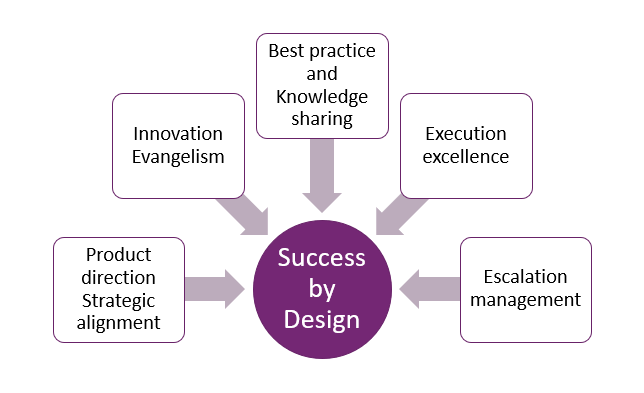Reasons to use Success by Design
When your team decides to follow Success by Design, you are on a good path to a successful implementation. The guidance relies on all participants to be actively engaged and actively sharing information. The guidance works best when enough information is shared to help ensure informed decision making.
Success by Design has been created to achieve five key goals on Dynamics 365 projects, as shown in the following diagram.
Product direction strategic alignment
Dynamics 365 and Microsoft Power Platform are rapidly evolving, and the way that you customize or design solutions on the platform today is different from how they were done a few years ago. A large part of a solution architect's role is making sure that customer and partner teams are aware and aligned with the product direction. Whether it's to do with using a Microsoft Power Automate flow instead of traditional workflows, or embedding canvas apps instead of using dialogs, these inputs are critical to a customer program and will help you save time and effort by avoiding rework later. Success by Design workshops give the project team critical insights into the customer program and an opportunity to provide timely recommendations to ensure alignment with Microsoft product strategy and roadmap.
Innovation evangelism
Dynamics 365 and Microsoft Power Platform enable digital transformation within customer organizations. The promise of a cloud-based digital transformation platform should allow organizations to innovate at a faster pace and have a competitive business advantage. One way to develop this competitive edge is adoption of the latest production innovations. It's important for you to determine if your customer's Dynamics Service Management system is using omnichannel capabilities and if they're using customer insights for AI. Success by Design provides you with an opportunity to influence the key project stakeholders through targeted feature recommendations during the workshops and help customers define their internal solution roadmap.
Best practices and knowledge sharing
Success by Design recommendations rely heavily on the learning and knowledge from working with different customers and actively sharing these insights with the solution architect community. Over time, the individual atomic Success by Design recommendations have been distilled into best practices to take the form of collateral that can be shared with those who are using the guidance.
Execution excellence
As individual contributors, solution architects are responsible for the success of their customers. Success by Design brings the necessary structure to drive greater consistency in the way that they can engage with their customers and in the way that they measure and report on their success. Success by Design also helps boost productivity and effectiveness through the following features:
A ready-made workshop template deck
Use of an on-demand TechTalk for standardized guidance
List of checkpoint questions to drive conversation
Reuse of recommendations across customers
Escalation management
Solution architects and project teams are familiar with reactive situations that can potentially derail a project and cause go-live delays. Implementation or performance issues could come from a bad design, from not following best practices, or due to product regression or bugs that are not fixed in time. While Success by Design should help minimize implementation-related escalations through proactive workshops and review checkpoints, you might still find yourself in escalation situations that will involve leadership and executives. A large part of escalation management is articulating the business impact and situation in the context of the customer. Success by Design can help provide the necessary context and historical perspective in the form of the workshop findings and recommendations, success measures, follow-up actions, and so on.
